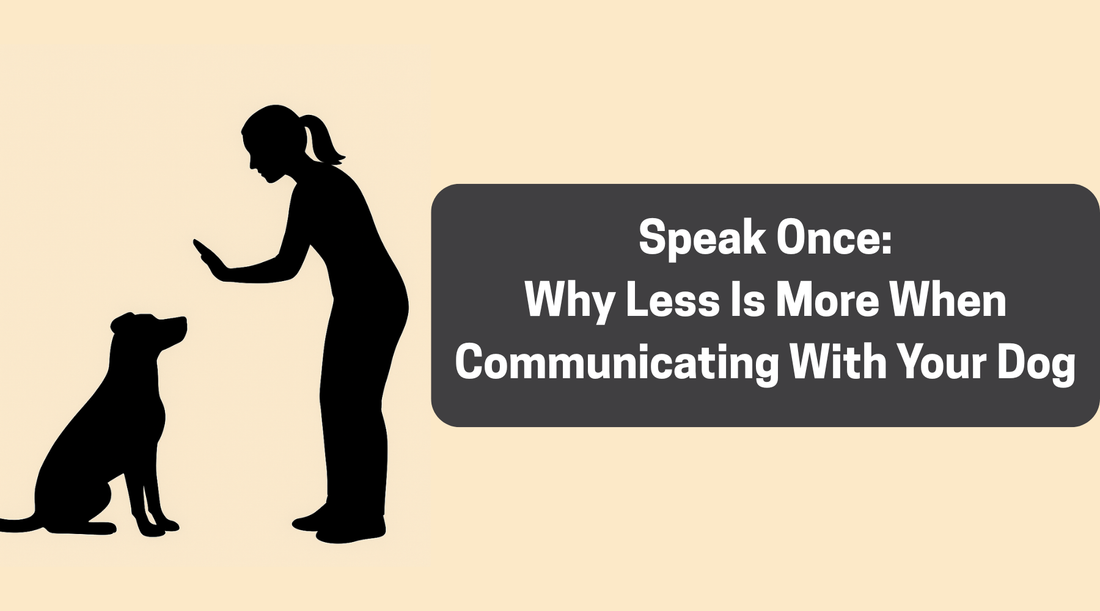Picture this: you’re standing in your kitchen, repeating “Sit! Sit! SIT!” while your dog stares up at you like you’re speaking a foreign language. Sound familiar? You’re not alone—and your dog isn’t being stubborn. Most of the time, they’re simply confused.
When it comes to dog training, more words don’t equal better communication. In fact, repeating cues, raising your voice, or layering multiple signals often creates the opposite effect. True clarity comes from timing, attention, and consistency—not volume.
Dogs Hear (and Notice) More Than We Think
Dogs can hear a treat bag open from three rooms away and detect sounds we’ll never notice. They don’t need louder cues; they need clear ones. Shouting doesn’t help them understand—it simply changes your tone and emotion, which your dog reads instantly. A calm, confident cue carries far more meaning than words said in frustration.
The Problem With Repeating Cues
Saying “Sit… sit… sit!” before your dog finally complies can backfire—you’ve just turned “sit” into a three-word command. Repetition turns a single, clear cue into background noise. Dogs learn patterns fast, and if a cue isn’t followed by immediate action (yours or theirs), it loses meaning. The goal is simple: your dog should hear a word once and know exactly what to do next.
If He Ain’t Listening, He Ain’t Learning
Training only works when your dog is ready to receive information. If their eyes and brain are elsewhere, your words won’t register. Before giving a cue, get your dog’s attention—say their name, wait for eye contact, or use a gentle gesture. Once they’re focused, learning can begin. Remember: attention first, cue second. If your dog isn’t listening, they aren’t learning.
Dogs Read Body Language First
Dogs are body-language experts. They notice your posture, movement, and facial expression long before they process a word. If your body says one thing and your mouth says another, your dog will choose the body every time. A still or quiet body helps your dog think. When your hands, feet, or shoulders are moving, your dog has to decide whether those motions are part of the cue or just background noise. But a calm, still body gives your dog space to focus and process what you’re asking—without distraction or guesswork. For example, saying “Stay” while leaning forward or stepping toward your dog can feel like pressure to move. A still body communicates confidence and quiet expectation—exactly what your dog needs to succeed.
When Verbal Cues Get Drowned Out
Here’s a little-known training truth: when two cues happen at once, one always overshadows the other. Usually, the visual cue wins. If you say “Sit” while using a hand signal, your dog is likely reading your hand—not listening to your word. To make verbal cues meaningful, separate them: say the cue, pause a second, then show the visual. This simple change helps your dog truly learn the word instead of guessing based on motion.
Building Clear Communication
Think of training as a calm conversation, not a list of commands. Aim for this rhythm: get your dog’s attention, say the cue once, pause, reward the correct response, and calmly reset if they miss it. Avoid raising your voice or repeating yourself—if your dog doesn’t respond, check your timing, clarity, or whether they’re fully focused. Every cue you give just once strengthens understanding and builds trust.
A Quiet Body, a Thinking Dog
When your body is calm, your dog can think clearly. Quick, shifting movements make dogs wonder what’s coming next—are we playing, are we training, are we leaving? A quiet, still body signals that it’s time to listen and focus. It’s one of the simplest ways to help your dog succeed in understanding your cues. When your movements are peaceful and deliberate, your dog’s brain has room to process instead of react.
Shifting Expectations
When people get frustrated, they tend to make cues louder, faster, and more emotional—all of which makes it harder for dogs to focus. The goal isn’t obedience under pressure; it’s communication under calm. The best results come when we slow down, stay attentive, and trust that our dogs are doing their best with the information we provide.
The Quiet Conversation
Some of the best trainers say very little. When both ends of the leash are fully tuned in, communication flows effortlessly. Speak once. Mean it. Pause for the response. The quieter you are, the more your dog can hear and understand you.
Trainer’s Corner: Quick Fixes for Cue Clarity
-
Attention Before Action: Never start talking until your dog’s eyes are on you. Try saying their name once, wait, then give the cue.
-
One Cue, One Chance: Say it once, then pause for 5-10 seconds. If there’s no response, reset the situation rather than repeating.
-
Separate Verbal and Visual: Say the cue first, pause half a second, then give your hand signal.
-
Quiet Body, Clear Mind: Keep your body still when you give a cue—your dog’s brain will focus on what you’re asking, not what you’re doing. Stillness adds clarity, confidence, and calm to every interaction.
- Stay Calm and Consistent: Dogs mirror our emotional tone. Soft, steady, and sure always wins over loud and impatient.

